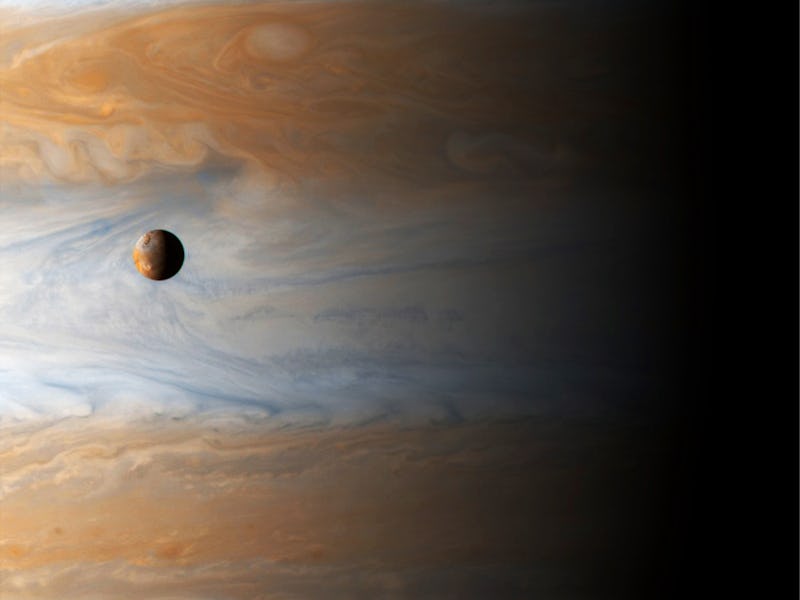Scientists Learn More About Jupiter’s Elusive Rocky Core and It’s as Weird as Ever
Deep flows from the planet's core to its whispy atmosphere will give Juno some hints

For something called a “gas giant,” Jupiter stops being an airy mass of vapor and clouds pretty early in. Just 10 percent of the distance down, along Jupiter’s radius toward its interior, the large volume of mostly hydrogen gas that makes up the planet’s atmosphere is compressed by gravity into a quantum fluid: liquid metal hydrogen.
Bear in mind that nobody has actually ever witnessed metallic hydrogen before — except allegedly these two guys at the the Max Planck Institute for Chemistry — but scientists are using its theoretical properties to teach NASA’s Juno probe how to read Jupiter’s atmosphere.
The complex interrelationships between these layers, according to a new study, could help prove the existence and size of Jupiter’s elusive rocky core.
Jupiter’s clearly banded stripes of cream-colored jet streams and eddies, the ones visible from space, are the by-product of oscillating wave that “exists from the surface down to the core” as Gary A. Glatzmaier a physicist at the University of California, Santa Cruz, tells Inverse.
“The restoring force, which drives the wave,” he says, “is the Coriolis force, which is really part of the fluid’s acceleration but acts like a force when viewed in the rotating frame of reference of the planet.” (Think of the gases molecules on Jupiter like marbles rolling around on a spinning carousel, in other words.)
Jupiter is rotating (like Earth) as it orbits the sun, and those forces along with thermal convection from solar rays and heat from the planet’s core — along with highly conductive electromagnetic behavior from that thick layer of metallic hydrogen liquid — are all exerting complicated effects on the Jovian weather patterns visible from space.
Some of Jupiter’s weird weather patterns will only exist if there’s a rocky core to Jupiter for these convective waves to bounce off. And the location of those weather patterns should have a relationship to the core’s size. Junocam will be picking up images of those weather patterns, but also other data that should help elucidate what’s going inside, like “banded patterns of magnetic field and gravity field,” Glatzmaier says.
Glatzmaier has been creating three-dimensional computer models simulating the behavior inside planets and stars since the 1980s — and his new modelling work on Jupiter, published Monday in the Proceedings of the National Academy of Sciences, takes three different stabs at how exactly the electromagnetic effects of Jupiter large “quantum liquid” middle might be conducting heat, and bending the gas giant’s magnetosphere, and generally contrubuting to weird phenomena.
Just to give you a strong visual sense of what weird means here: If Jupiter has a rocky core, it’s estimated to be a little bit larger than Earth. That’s surrounded by this turbulent pool of liquid metal hydrogen tens of thousands of miles in radius, and then a comparatively much thinner layer of gaseous atmosphere.
Here’s what the calculated magnetic fields around Jupiter come out to in one of Glatzmaier’s simulations (left) as compared to a Los Alamos simulation of Earth’s magnetosphere (right):
Simulations illustrating Jupiter's magentic field (left) and Earth's (right)
“There are so many properties we don’t know about in Jupiter’s deep interior,” Glatzmaier says. “Even this relatively simple model requires so much supercomputer resources to simulate just a few years of time.”
One of Glatzmaier’s three recent simulations of Jupiter showed an interesting oscillating jet stream, sometimes flowing eastward, sometimes, flowing westward, for two consistent years of the computer model’s 20-some-odd-years of simulated Jupiter time.
“The oscillating jet stream,” he says, “is something never suggested or detected before.” Confirmation of its existence from Juno would allow the Jupiter’s rocky core to be extrapolated from Glatzmaier’s simulations, but he’s recognizes that it might be a long shot. “Although it would be exciting to see.”